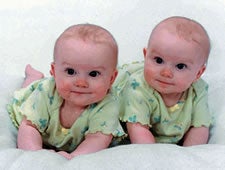Twin beginnings usually result in single births, researcher says
For one in every eight people, the lesson of sharing may have started from the moment of conception. Figuring out if you originally had a roommate in the womb is a mystery that Dr. Charles Boklage has sought to understand for the past 20 years.
Boklage, a professor in the Department of Pediatrics in the Brody School of Medicine and adjunct professor of biology at East Carolina University, has studied twins, their relationship to right- and left-handedness and their higher risk of birth defects or deformities.

Tess, left, and Mary Lou Dillard, 7 months, made it from conception to birth as twins, much to the delight of Dr. Stephen Thomas, their granddad and dean of the ECU School of Allied Health Sciences.
A father of twin girls, Boklage is fascinated by the complexity of early human development and a concept sometimes referred to as the vanishing twin syndrome. The factors that cause one embryo to thrive while the other is absorbed into the lining of the uterus or when one embryo has a genetic flaw that triggers a spontaneous abortion are still unknown.
“For many twin conceptions, one of the embryos will not make it to the point of pregnancy recognition, which usually occurs around six weeks once a woman has missed her second consecutive menstrual cycle,” Boklage said. “Only one in every 50 twin conceptions will arrive at birth as live twins.”
The extensive use of fertility drugs coupled with women delaying pregnancy is also producing a marked increase in the number of twin conceptions and live births. Unlike single births, twins are more likely to be born prematurely and at a lower birth weight. According to the Centers for Disease Control and Prevention, twins account for approximately 2 percent of all live births in the United States and an even higher percentage of birth-related problems.
“The risk for low birthweight among twins is seven times greater than among singletons,” the CDC reported in 1997 following an assessment of twin births from 1980-1994. “In addition, twins account for 17 percent of all LBW infants and approximately 12 percent of all infant deaths.”
With the expanded use of genetic and DNA testing, a new wrinkle in the human development mystery is surfacing ” whether babies born as singletons are carrying one set of genetic code in their bodies or whether two embryos merged in the early stages of development to form a single person.
Boklage includes the concept of chimeras in his genetics course and says it’s a concept that many people have a hard time accepting.
“The egg is the largest and most complex human cell,” Boklage said. “I’m certain that chimeras are far more common than we realize, and it’s something that happens entirely by accident in normal, healthy people. Most people don’t want to think that these kinds of things even happen.”